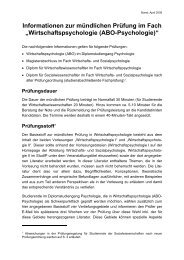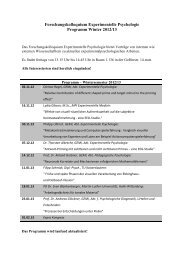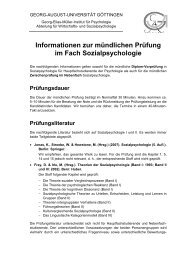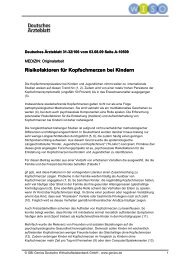Competence and performance in causal learning
Competence and performance in causal learning
Competence and performance in causal learning
Create successful ePaper yourself
Turn your PDF publications into a flip-book with our unique Google optimized e-Paper software.
228 WALDMANN AND WALKER<br />
<strong>in</strong>crease the likelihood that an associative mechanism<br />
with its built-<strong>in</strong> mechanism of cue competition would<br />
take over.<br />
In our view, the most promis<strong>in</strong>g general approach to<br />
the psychology of <strong>causal</strong>ity is the research strategy most<br />
l<strong>in</strong>guists choose for the analysis of language (Chomsky,<br />
1965). We should start with models that describe our<br />
competence before we deal with conditions that prevent<br />
people from display<strong>in</strong>g their competence. If we want to<br />
learn about our language faculty, then we should give<br />
participants the opportunity to show what they can do.<br />
Later we can study errors people make under different<br />
conditions. Similarly, it is more <strong>in</strong>formative to explore<br />
what people can do when learn<strong>in</strong>g about <strong>causal</strong> relations<br />
under optimal conditions before we <strong>in</strong>vestigate conditions<br />
<strong>in</strong> which their competence fails. The models describ<strong>in</strong>g<br />
competence can then be used to p<strong>in</strong>po<strong>in</strong>t potential<br />
break po<strong>in</strong>ts that cause people to make errors.<br />
REFERENCES<br />
B<strong>in</strong>dra, D., Clarke, K. A., & Shultz, T. R. (1980). Underst<strong>and</strong><strong>in</strong>g<br />
predictive relations of necessity <strong>and</strong> sufficiency <strong>in</strong> formally equivalent<br />
“<strong>causal</strong>” <strong>and</strong> “logical” problems. Journal of Experimental Psychology:<br />
General, 109, 422-443.<br />
Chapman, G. B., & Robb<strong>in</strong>s, S. J. (1990). Cue <strong>in</strong>teraction <strong>in</strong> human<br />
cont<strong>in</strong>gency judgment. Memory & Cognition, 18, 537-545.<br />
Cheng, P. W. (1997). From covariation to causation: A <strong>causal</strong> power<br />
theory. Psychological Review, 104, 367-405.<br />
Chomsky, N. (1965). Aspects of the theory of syntax. Cambridge, MA:<br />
MIT Press.<br />
Cobos, P. L., López, F. J., Cano, A., Alvarez, J., & Shanks, D. R.<br />
(2002). Mechanisms of predictive <strong>and</strong> diagnostic <strong>causal</strong> <strong>in</strong>duction.<br />
Journal of Experimental Psychology: Animal Behavior Processes,<br />
28, 331-346.<br />
De Houwer, J. (2002). Forward block<strong>in</strong>g depends on retrospective <strong>in</strong>ferences<br />
about the presence of the blocked cue dur<strong>in</strong>g the elemental<br />
phase. Memory & Cognition, 30, 24-33.<br />
De Houwer, J., & Beckers, T. (2002). Higher-order retrospective<br />
revaluation <strong>in</strong> human <strong>causal</strong> learn<strong>in</strong>g. Quarterly Journal of Experimental<br />
Psychology, 55B, 137-151.<br />
De Houwer, J., & Beckers, T. (2003). Secondary task difficulty modulates<br />
forward block<strong>in</strong>g <strong>in</strong> human cont<strong>in</strong>gency learn<strong>in</strong>g. Quarterly<br />
Journal of Experimental Psychology, 56B, 345-357.<br />
De Houwer, J., Beckers, T., & Glautier, S. (2002). Outcome <strong>and</strong> cue<br />
properties modulate block<strong>in</strong>g. Quarterly Journal of Experimental<br />
Psychology, 55A, 965-985.<br />
Esmoris-Arranz, F. J., Miller, R. R., & Matute, H. (1997). Block<strong>in</strong>g<br />
of antecedent <strong>and</strong> subsequent events: Implications for cue competition<br />
<strong>in</strong> <strong>causal</strong>ity judgment. Journal of Experimental Psychology:<br />
Animal Behavior Processes, 23, 145-156.<br />
Fenker, D., Waldmann, M. R., & Holyoak, K. J. (<strong>in</strong> press). Access<strong>in</strong>g<br />
<strong>causal</strong> relations <strong>in</strong> semantic memory. Memory & Cognition.<br />
Glymour, C. (2001). The m<strong>in</strong>d’s arrows: Bayes nets <strong>and</strong> graphical<br />
<strong>causal</strong> models <strong>in</strong> psychology. Cambridge, MA: MIT Press.<br />
Glymour, C. (2003). Learn<strong>in</strong>g, prediction <strong>and</strong> <strong>causal</strong> Bayes nets. Trends<br />
<strong>in</strong> Cognitive Science, 7, 43-48.<br />
Goedert, K. M., & Spellman, B. A. (2005). Nonnormative discount<strong>in</strong>g:<br />
There is more to cue <strong>in</strong>teraction effects than controll<strong>in</strong>g for alternative<br />
causes. Learn<strong>in</strong>g & Behavior, 33, 197-210.<br />
Gopnik, A., Glymour, C., Sobel, D. M., Schulz, L. E., Kushnir, T.,<br />
& Danks, D. (2004). A theory of <strong>causal</strong> learn<strong>in</strong>g <strong>in</strong> children: Causal<br />
maps <strong>and</strong> Bayes nets. Psychological Review, 111, 3-32.<br />
Hagmayer, Y., & Waldmann, M. R. (2002). How temporal assumptions<br />
<strong>in</strong>fluence <strong>causal</strong> judgments. Memory & Cognition, 30, 1128-1137.<br />
Keppel, G., & Wickens, T. D. (2004). Design <strong>and</strong> analysis: A researcher’s<br />
h<strong>and</strong>book (4th ed.). Upper Saddle River, NJ: Prentice-<br />
Hall.<br />
Lovibond, P. F. (2003). Causal beliefs <strong>and</strong> conditioned responses: Retrospective<br />
revaluation <strong>in</strong>duced by experience <strong>and</strong> by <strong>in</strong>struction.<br />
Journal of Experimental Psychology: Learn<strong>in</strong>g, Memory, & Cognition,<br />
29, 97-106.<br />
Matute, H., Arcediano, F., & Miller, R. R. (1996). Test question<br />
modulates cue competition between causes <strong>and</strong> between effects.<br />
Journal of Experimental Psychology: Learn<strong>in</strong>g, Memory, & Cognition,<br />
22, 182-196.<br />
Münte, T. F., Schiltz, K., & Kutas, M. (1998). When temporal terms<br />
belie conceptual order. Nature, 395, 71-73.<br />
Pearl, J. (2000). Causality: Models, reason<strong>in</strong>g, <strong>and</strong> <strong>in</strong>ference. Cambridge:<br />
Cambridge University Press.<br />
Price, P. C., & Yates, J. F. (1995). Associative <strong>and</strong> rule-based accounts<br />
of cue <strong>in</strong>teraction <strong>in</strong> cont<strong>in</strong>gency judgment. Journal of Experimental<br />
Psychology: Learn<strong>in</strong>g, Memory, & Cognition, 21, 1639-1655.<br />
Rescorla, R. A., & Wagner, A. R. (1972). A theory of Pavlovian condition<strong>in</strong>g:<br />
Variations <strong>in</strong> the effectiveness of re<strong>in</strong>forcement <strong>and</strong> nonre<strong>in</strong>forcement.<br />
In A. H. Black & W. F. Prokasy (Eds.), Classical condition<strong>in</strong>g<br />
II: Current research <strong>and</strong> theory (pp. 64-99). New York:<br />
Appleton-Century-Crofts.<br />
Shanks, D. R., & López, F. J. (1996). Causal order does not affect cue<br />
selection <strong>in</strong> human associative learn<strong>in</strong>g. Memory & Cognition, 24,<br />
511-522.<br />
Spirtes, P., Glymour, C., & Sche<strong>in</strong>es, R. (1993). Causation, prediction,<br />
<strong>and</strong> search. New York: Spr<strong>in</strong>ger-Verlag.<br />
Steyvers, M., Tenenbaum, J. B., Wagenmakers, E.-J., & Blum, B.<br />
(2003). Inferr<strong>in</strong>g <strong>causal</strong> networks from observations <strong>and</strong> <strong>in</strong>terventions.<br />
Cognitive Science, 27, 453-489.<br />
Tangen, J. M., & Allan, L. G. (2004). Cue <strong>in</strong>teraction <strong>and</strong> judgments<br />
of <strong>causal</strong>ity: Contributions of <strong>causal</strong> <strong>and</strong> associative processes. Memory<br />
& Cognition, 32, 107-124.<br />
Tangen, J. M., Allan, L. G., & Sadeghi, H. (2005). Assess<strong>in</strong>g<br />
(<strong>in</strong>)sensitivity to <strong>causal</strong> asymmetry: A matter of degree. In A. Wills<br />
(Ed.), New directions <strong>in</strong> human associative learn<strong>in</strong>g (pp. 65-93).<br />
Hillsdale, NJ: Erlbaum.<br />
Van Hamme, L. J., Kao, S. F., & Wasserman, E. A. (1993). Judg<strong>in</strong>g <strong>in</strong>terevent<br />
relations: From cause to effect <strong>and</strong> from effect to cause.<br />
Memory & Cognition, 21, 802-808.<br />
Waldmann, M. R. (1996). Knowledge-based <strong>causal</strong> <strong>in</strong>duction. In D. R.<br />
Shanks, K. J. Holyoak, & D. L. Med<strong>in</strong> (Eds.), The psychology of<br />
learn<strong>in</strong>g <strong>and</strong> motivation: Vol 34. Causal learn<strong>in</strong>g (pp. 47-88). San<br />
Diego: Academic Press.<br />
Waldmann, M. R. (2000). Competition among causes but not effects<br />
<strong>in</strong> predictive <strong>and</strong> diagnostic learn<strong>in</strong>g. Journal of Experimental Psychology:<br />
Learn<strong>in</strong>g, Memory, & Cognition, 26, 53-76.<br />
Waldmann, M. R. (2001). Predictive versus diagnostic <strong>causal</strong> learn<strong>in</strong>g:<br />
Evidence from an overshadow<strong>in</strong>g paradigm. Psychological Bullet<strong>in</strong><br />
& Review, 8, 600-608.<br />
Waldmann, M. R., & Hagmayer, Y. (2001). Estimat<strong>in</strong>g <strong>causal</strong> strength:<br />
The role of structural knowledge <strong>and</strong> process<strong>in</strong>g effort. Cognition,<br />
82, 27-58.<br />
Waldmann, M. R., & Hagmayer, Y. (2005). See<strong>in</strong>g versus do<strong>in</strong>g: Two<br />
modes of access<strong>in</strong>g <strong>causal</strong> knowledge. Journal of Experimental Psychology:<br />
Learn<strong>in</strong>g, Memory, & Cognition, 31, 216-227.<br />
Waldmann, M. R., & Holyoak, K. J. (1992). Predictive <strong>and</strong> diagnostic<br />
learn<strong>in</strong>g with<strong>in</strong> <strong>causal</strong> models: Asymmetries <strong>in</strong> cue competition.<br />
Journal of Experimental Psychology: General, 121, 222-236.<br />
Waldmann, M. R., & Holyoak, K. J. (1997). Determ<strong>in</strong><strong>in</strong>g whether<br />
<strong>causal</strong> order affects cue selection <strong>in</strong> human cont<strong>in</strong>gency learn<strong>in</strong>g: Comments<br />
on Shanks <strong>and</strong> López (1996). Memory & Cognition, 25, 125-134.<br />
Waldmann, M. R., Holyoak, K. J., & Fratianne, A. (1995). Causal<br />
models <strong>and</strong> the acquisition of category structure. Journal of Experimental<br />
Psychology: General, 124, 181-206.<br />
Waldmann, M. R., & Martignon, L. (1998). A Bayesian network<br />
model of <strong>causal</strong> learn<strong>in</strong>g. In M. A. Gernsbacher & S. J. Derry (Eds.),<br />
Proceed<strong>in</strong>gs of the Twentieth Annual Conference of the Cognitive Science<br />
Society (pp. 1102-1107). Mahwah, NJ: Erlbaum.<br />
Williams, D. A., Sagness, K. E., & McPhee, J. E. (1994). Configural











